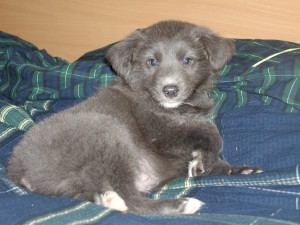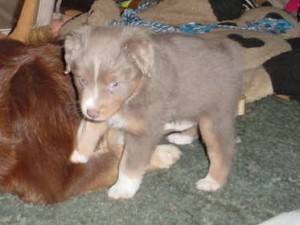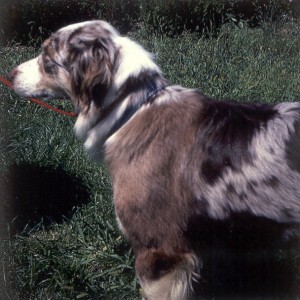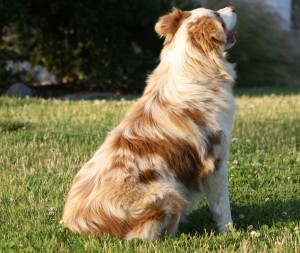
Dilution, variously called D-locus dilution and maltese dilute, as well as several breed-specific names, is probably the most common unacceptable color in Australian Shepherds. A dilute’s color will be slate blue in all the places one would expect black in dogs who are genetically black or blue merle and roughly the color of a Weimeraner or a Chesapeake Bay Retriever in the places

you would expect liver in dogs that are genetically liver (red) or liver (red) merle. There will be no true black or liver spots on a dilute in the coat or on the skin.
Merles can be dilutes. Blue merles will have slate blue dark patches on a lighter blue background amd their noses and other exposed skin will be slate blue. Red merle dilutes have medium-toned dark patches on a pale background with pale liver on the nose and other exposed skin. Given the extreme variation in red pigmentation in “normal” reds and red merles it is possible that a dilute might not be recognized as such. Dilution affects only the areas of the coat that would have been black or liver. Neither tan nor white markings are affected.
The mutation of the MLPH gene which is responsible for dilute color in a number of other breeds is present in the Aussie. It is a recessive, so both parents of a dilute must carry the mutation. There is a DNA test, however not every dilute Aussie has this mutation. Some dilute Australian Shepherds are born dilute but darken as they mature, often to a point that they are indistinguishable from a normally colored dog. Not all dilute Aussies have the MLPH dilution and these dogs are likely among them.

Dilution spots, isolated areas of dull, rusty color found on merles, are not the same as dilution. Merles that have them tend to produce puppies that have them, so there is probably some degree of inheritance. Researchers currently think this may be due to a variation in the merle gene. Dilution spots are not disallowed, but they are considered faulty.
Tweed Pattern – this multi-shade merle patterning has sometimes been described as “harlequin,” however this is a poor term because it can cause confusion with the genetically distinct harlequin pattern seen in Great Danes. It is described in the scientific literature as “tweed” and

therefore that is what is used here. Tweed was for many years felt to be recessive but it, like dilution spots, may also be due to a variation in merle. The color of tweed merles is clear, not muddy or rusty like dilution spots. It isn’t specifically faulted in the standards but because it is rarely seen in the ring a judge might fault it.
